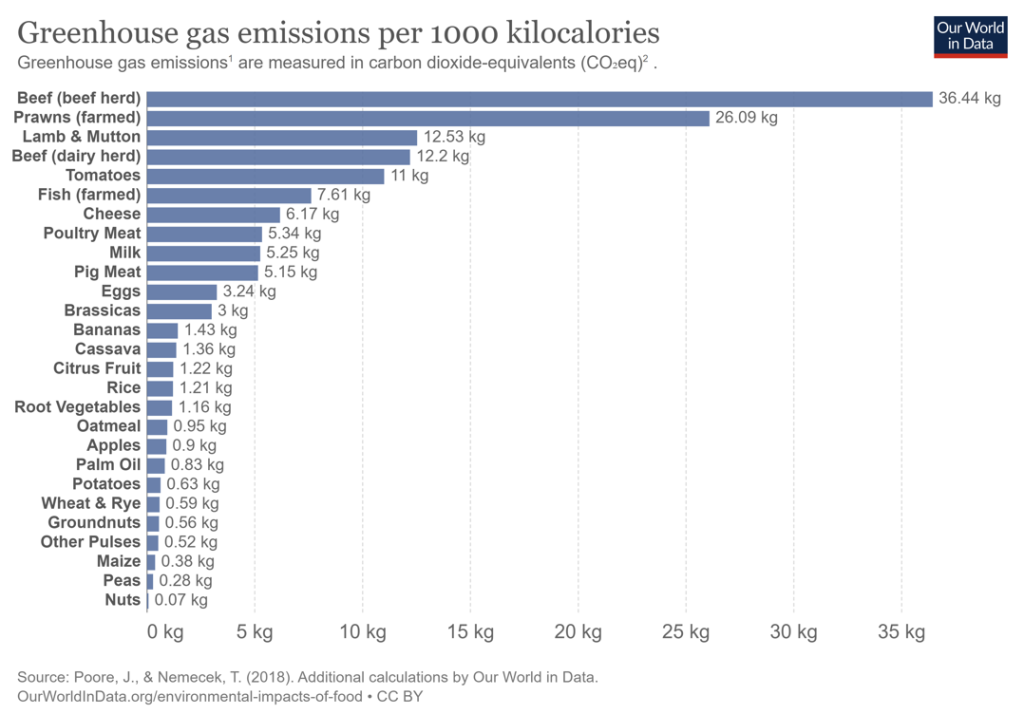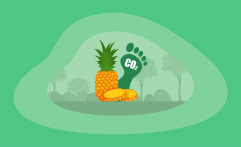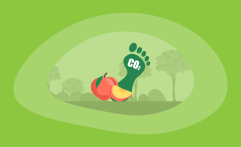What Is the Carbon Footprint of Papayas? A Life-Cycle Analysis
Impactful Ninja is reader-supported. When you buy through links on our site, we may earn an affiliate commission.
Learn more
Learn more
.
Hey fellow impactful ninja ? You may have noticed that Impactful Ninja is all about providing helpful information to make a positive impact on the world and society. And that we love to link back to where we found all the information for each of our posts. Most of these links are informational-based for you to check out their primary sources with one click. But some of these links are so-called "affiliate links" to products that we recommend. First and foremost, because we believe that they add value to you. For example, when we wrote a post about the environmental impact of long showers, we came across an EPA recommendation to use WaterSense showerheads. So we linked to where you can find them. Or, for many of our posts, we also link to our favorite books on that topic so that you can get a much more holistic overview than one single blog post could provide. And when there is an affiliate program for these products, we sign up for it. For example, as Amazon Associates, we earn from qualifying purchases. First, and most importantly, we still only recommend products that we believe add value for you. When you buy something through one of our affiliate links, we may earn a small commission - but at no additional costs to you. And when you buy something through a link that is not an affiliate link, we won’t receive any commission but we’ll still be happy to have helped you. When we find products that we believe add value to you and the seller has an affiliate program, we sign up for it. When you buy something through one of our affiliate links, we may earn a small commission (at no extra costs to you). And at this point in time, all money is reinvested in sharing the most helpful content with you. This includes all operating costs for running this site and the content creation itself. You may have noticed by the way Impactful Ninja is operated that money is not the driving factor behind it. It is a passion project of mine and I love to share helpful information with you to make a positive impact on the world and society. However, it's a project in that I invest a lot of time and also quite some money. Eventually, my dream is to one day turn this passion project into my full-time job and provide even more helpful information. But that's still a long time to go. Stay impactful,Affiliate Disclosure
Why do we add these product links?
What do these affiliate links mean for you?
What do these affiliate links mean for us?
What does this mean for me personally?
![]()
Papayas are a soft, sweet fruit native to Mexico. Today, they are grown everywhere from Florida to Hawaii. Papayas are also highly versatile. For example, they are commonly used in salads, desserts, and ice creams. But papayas can also have a significant impact on the earth. The processes used in their growth, transportation, and disposal can rack up some serious emissions. So, we had to ask: What is the carbon footprint of papayas?
Papayas have a moderate carbon footprint of 0.3kg (0.67lb) of CO2e per pound of papayas. This is mainly because of their refrigerated shipping from Mexico, use of styrofoam packaging, high irrigation requirements, and low composting rates.
In this article, we will look at the full life-cycle of papayas, investigating how each stage contributes to their carbon footprint. We will go through all of the main stages of papayas’ production—starting with growth and then going through harvesting, processing, transportation, and ending at waste disposal—and will evaluate how each stage contributes to papayas’ carbon footprint. So, let’s get into the carbon footprint of papayas!
Here’s How We Assessed the Carbon Footprint of Papayas
The carbon footprint is one of the ways we measure the effects of our human-induced global climate change. It primarily focuses on the greenhouse gas (GHG) emissions associated with consumption, but also includes other emissions such as methane (CH4), nitrous oxide, and chlorofluorocarbons, and is generally expressed in carbon dioxide equivalents (CO2e).
“Carbon footprint: the amount of greenhouse gasses and specifically carbon dioxide emitted by something (such as a person’s activities or a product’s manufacture and transport) during a given period”
Merriam Webster
Basically, it is the amount of carbon emitted by you as an individual or an organization providing you with goods and services – including papayas:
- This includes GHG emissions from producing the products that we use and foods that we eat (e.g., power plants, factories or farms, and landfills)
- GHG emissions from fuel that we burn directly or indirectly (e.g., logistics and transportation, cooling or heating facilities),
- as well as the GHG emissions attributed to how we consume these products and foods.
To understand the carbon footprint of papayas, we must assess their life-cycle and each stage’s sustainability. This life-cycle assessment (LCA) is a method to evaluate the environmental impacts of products and materials.
Here’s the Overall Carbon Footprint of Papayas
The overall carbon footprint of papayas is moderate at 0.3kg (0.67lb) of CO2e per pound of papayas. The main factors that contribute to this are the use of styrofoam packaging, international refrigerated shipping, and their high irrigation needs.
Papayas do a lot right when it comes to their carbon footprint. For example, they yield more than average per hectare, they don’t use a lot of pesticides, and they are grown in North America. However, there are still many things they do to rack up significant carbon emissions.
| The carbon footprint of papayas | 0.3kg (0.67lb) of CO2e per pound of papayas |
So, let’s have a look at each stage of the LCA of papayas!
| The life-cycle stages of papayas | Each stage’s carbon footprint |
| Growing of papayas | The carbon footprint of growing papayas is low. Despite high irrigation requirements, papayas have an economical growth yield, short growth duration, and low pesticide use. |
| Harvesting, processing, and packaging of papayas | The carbon footprint of harvesting, processing, and packaging papayas is moderate. This is caused by the energy used during their processing and their use of styrofoam packaging. |
| Transporting of papayas | The carbon footprint of transporting papayas is moderate. This is because they need to be transported from Mexico in refrigerated cargo containers. |
| End-of-life of papayas | The carbon footprint of the end-of-life of papayas is high because of their low composting rates and use of styrofoam packaging. |
The stage that contributes the most to papayas’ carbon footprint is waste management. This is mainly because they use styrofoam packaging, but also because of low composting rates among food waste. Harvesting and transporting are also significant because of the energy used in processing and refrigeration.
What Is the Carbon Footprint of Growing Papayas
The carbon footprint of growing papayas is low. Despite high irrigation requirements, papayas have an economical growth yield, short growth duration, and low pesticide use.
The process of growing papayas generally has a low carbon footprint, depending on the methods used. Factors like the amount of irrigation, deforestation, and pesticide use can all contribute to the overall impact of the growth stage.
Which factors impact the carbon footprint of growing papayas?
- How do papayas grow: Papayas grow on small trees in subtropical climates. These trees have excellent carbon sequestering properties, which helps to offset some of their emissions by storing carbon. As a result, this stage has a very low carbon footprint.
- What is the growth duration of papayas: The longer the growth frame, the higher the carbon footprint because more resources are required to sustain the plants. Papaya plants can start producing fruit in the first year of growth, as early as 7 months after planting. This is incredibly fast for a tree fruit, which tend to not produce fruit until 3–4 years after planting, such as apricot trees. Individual papayas can go from flower to fruit in as little as 3 months. This is also on the shorter side amongst plants. For example, pineapples take around 12 months to grow. Therefore, the growth duration of papayas contributes minimally to their overall carbon footprint.
- What is the land usage of papayas: When fruits use less land, they require less deforestation and resources to sustain them. Papayas yield around 60–75 tons per hectare. This is incredibly high for fruits, given that watermelons have a yield of only around 2–3 tons per hectare. Therefore, this stage is also a very minor contributor to papayas’ carbon footprint.
- What is the water usage of papayas: Papayas need around 1–2 inches of water per week. Most papayas consumed in the US are grown in Mexico, which only gets around 28 inches of rain per year. This is a far cry from the 52–104 inches papayas need and therefore they require a lot of irrigation. Irrigation has a high carbon footprint and so this stage contributes significantly to papayas’ overall footprint.
- What is the pesticide and fertilizer usage of papayas: Papayas use a very low amount of pesticides, being included on a list of the lowest pesticide users. This is due to a genetic modification that has made them naturally resistant to certain pests. Because of this, papayas avoid the high carbon footprint that comes with pesticides. This stage then has a low carbon footprint.
Papayas do well in a lot of categories. To help reduce your papaya carbon footprint further, you can purchase papayas grown in Florida, which is much rainier and so less irrigation is required.
In short, the irrigation requirements of papayas do raise their carbon footprint. But if you take into account how much they yield per hectare, how quickly they grow, and how few pesticides they use, their carbon footprint in this area is low overall.
What Is the Carbon Footprint of Harvesting, Processing, and Packaging Papayas
The carbon footprint of harvesting, processing, and packaging papayas is moderate. This is caused by the energy used during their processing and their use of styrofoam packaging.
The next major stage in the life-cycle of papayas’ carbon emissions is harvesting, processing, and packaging. This involves picking the fruit, checking it for damage, sorting it, and getting it ready for distribution. This stage can contribute greatly to the carbon footprint of the fruit depending on the processes used.
Which factors impact the carbon footprint of harvesting, processing, and packaging papayas?
- How are papayas harvested: Papayas are typically harvested by hand. Manual harvesting doesn’t require energy to run. Therefore, papayas have a very low carbon footprint at this stage.
- How are papayas processed: Papayas are processed using temperature treatment to kill pests. This treatment involves submerging them in hot water. Since heating up water requires energy, this stage has a moderate carbon footprint.
- How are papayas packaged: Papayas are generally packaged using two main materials: cardboard for the boxes and styrofoam for the cushioned sleeves. Both cardboard and styrofoam have high production carbon footprints. Thus, this stage plays a significant role in papayas’ carbon footprint.
Papayas have some areas where they could use improvement in the carbon department. Buying papayas with as little packaging as possible is one of the best ways to reduce your carbon footprint for this stage.
In short, the fact that papayas use so much packaging, especially styrofoam packaging, and require energy to process means that their carbon footprint in this stage is moderate.
What Is the Carbon Footprint of Transporting Papayas
The carbon footprint of transporting papayas is moderate. This is because they need to be transported from Mexico in refrigerated cargo containers.
Papayas’ journeys have just started when they are packaged. They then have to travel the distance between the farm and the grocery store. The distance, as well as the method through which they have to travel, are the two most important factors in determining the carbon footprint of their transportation.
Which factors impact the carbon footprint of transporting papayas?
- Where are papayas grown: Around 75% of papayas consumed in the US are grown in Mexico. Though Mexico is outside of the US and thus requires longer travel times, it is still in North America and so has a lower carbon footprint than fruit grown in Asia or Oceania. Therefore, the distance from farm to table contributes moderately to papayas’ carbon footprint.
- How are papayas transported: Papayas are transported on cargo ships to the US. The containers in which they are shipped need to be refrigerated to help slow down the papaya ripening process. Refrigerated cargo containers have a higher carbon footprint than dry good containers and so this stage has a high carbon footprint.
The international shipping of fruit has a high carbon footprint. If you want to lower your carbon footprint in this area, you should try to buy domestic papayas to cut down on travel times and fuel.
In short, the use of refrigeration in the transport process, and the international shipping distances all drive up papayas’ carbon footprint.
What Is the Carbon Footprint of the End-of-Life of Papayas
The carbon footprint of the end-of-life of papayas is high because of their low composting rates and use of styrofoam packaging.
Papayas’ carbon footprint journey isn’t done after you consume them. In fact, one of the most important factors that will determine the overall carbon footprint of papayas is how their waste is disposed of. Here, we will look at how this stage in the process affects papayas’ carbon footprint.
Which factors impact the carbon footprint of the end-of-life of papayas?
- How are papayas disposed of: Papayas have peels that are generally not eaten. These are technically compostable, but since only 4% of food is actually composted, they are likely to end up in landfill. Furthermore, when food is put in landfill, it creates methane, which is a greenhouse gas. Thus, this stage contributes significantly to papayas’ carbon footprint.
- How is the packaging of papayas disposed of: Papayas use both cardboard and styrofoam in their packaging. Cardboard can be recycled and has a very high recycling rate at 89%. However, styrofoam has an extremely low recycling rate, at around 1%. Even worse, styrofoam takes around 500 years to break down effectively. Mainly because of styrofoam, the carbon footprint of this stage is high.
The packaging involved in papaya distribution is a big problem. Buying papayas without packaging or at least without styrofoam packaging, will help you to keep your carbon footprint low in this area.
In short, the incredibly low recycling rates of styrofoam, as well as the low composting rates of food waste mean that papayas have a high waste carbon footprint.
How Does the Carbon Footprint of Papayas Compare to Other Types of Food
Papayas have a moderate carbon footprint compared to other fruits and when compared to foods in general. With fruit, however, they are in the higher middle, whereas compared to foods in general, they are in the lower middle. This is because fruit as a category generally has a lower carbon footprint.
Papayas have a moderate carbon footprint compared to other foods. When assessing the carbon footprint of a particular food, it is always important to place it in the context of other foods. This can help you to see the relative impact they have and assist you in making decisions between different foods based on their carbon footprint. In this next part of the article, we will show you how papayas compare to other foods in terms of carbon footprint.
How Does the Carbon Footprint of Papayas Compare to Other Types of Fruits/Vegetables/Nuts
Papayas have an average carbon footprint when compared to other fruits. Fruits in general tend to have lower carbon footprints than many other foods, like dairy products. However, there is still a lot of variation between them. Different transportation distances, the density of orchards, variations in growing methods, and pesticide use can all add up to contribute to their carbon footprints. Here, we will look at how papayas compare specifically to other fruits in terms of carbon footprint.
| Fruits | Carbon Footprint per lbs | Calories per lbs | Carbon Footprint per Calories |
| Avocados | 0.85 kg (1.9 lb) of CO2e per pound of avocados | 725 calories per pound | 1.17kg (2.57lb) of CO2e per 1,000 calories of avocados |
| Grapes | 0.64 kg (1.42 lbs) of CO2e per pound of grapes | 300 calories per pound | 2.13kg (4.7lb) of CO2e per 1,000 calories of grapes |
| Cantaloupe | 0.58kg (1.3lb) of CO2e per pound of cantaloupe | 154 calories per pound | 3.77kg (8.31lb) of CO2e per 1,000 calories of cantaloupes |
| Kiwis | 0.56kg (1.24lb) of CO2e per pound of kiwis | 277 calories per pound | 2.02kg (4.45lb) of CO2e per 1,000 calories of kiwis |
| Blueberries | 0.45kg (1lb) of CO2e per pound of blueberries | 256 calories per pound | 1.75kg (3.86lb) of CO2e per 1,000 calories of blueberries |
| Plums | 0.4 kg (0.88 lb) CO2e per pound of plums | 209 calories per pound | 1.91kg (4.21lb) of CO2e per 1,000 calories of plums |
| Strawberries | 0.39kg (0.88lb) of CO2e per pound of strawberries | 145 calories per pound | 2.69kg (5.93lb) of CO2e per 1,000 calories of strawberries |
| Pomegranates | 0.39kg (0.87lb) of CO2e per pound of pomegranates | 375 calories per pound | 1.04kg (2.29lb) of CO2e per pound of pomegranates |
| Figs | 0.3kg (0.68lb) of CO2e per pound of figs | 333 calories per pound | 0.9kg (1.98lb) of CO2e per 1,000 calories of figs |
| Papayas | 0.3kg (0.67lb) of CO2e per pound of papayas | 195 calories per pound | 1.54kg (3.4lb) of CO2e per 1,000 calories of papayas |
| Oranges | 0.3kg (0.66 lb) CO2e per pound of oranges | 213 calories per pound | 1.41kg (3.11lb) of CO2e per 1,000 calories of oranges |
| Dates | 0.27kg (0.6lb) of CO2e per pound of dates | 1,300 calories per pound | 0.21kg (0.46lb) of CO2e per 1,000 calories of dates |
| Apples | 0.24 kg (0.53 lb) of CO2e per pound of apples | 236 calories per pound | 1.02kg (2.25lb) of CO2e per 1,000 calories of apples |
| Pears | 0.23kg (0.52 lb) of CO2e per pound of pears | 259 calories per pound | 0.89kg (1.96lb) of CO2e per 1,000 calories of pears |
| Bananas | 0.21 kg (0.48 lb) of CO2e per pound of banana | 404 calories per pound | 0.52kg (1.15lb) of CO2e per 1,000 calories of bananas |
| Mangoes | 0.21 kg (0.46 lb) CO2e per pound of mangoes | 272 calories per pound | 0.77lb (1.7lb) of CO2e per 1,000 calories of mangoes |
| Cherries | 0.19kg (0.41 lb) of CO2e per pound of cherries | 227 calories per pound | 0.84kg (1.85lb) of CO2e per 1,000 calories of cherries |
| Limes | 0.18kg (0.39lb) of CO2e per pound of limes | 136 calories per pound | 1.32kg (2.91lb) of CO2e per 1,000 calories of limes |
| Peaches | 0.17kg (0.38lb) CO2e per pound of peaches | 176 calories per pound | 0.97kg (2.14lb) of CO2e per 1,000 calories of peaches |
| Apricots | 0.16kg (0.36lb) of CO2e per pound of apricots | 218 calories per pound | 0.73kg (1.61lb) of CO2e per 1,000 calories of apricots |
| Raspberries | 0.15kg (0.33lb) of CO2e per pound of raspberries | 240 calories per pound | 0.63kg (1.39lb) of CO2e per 1,000 calories of raspberries |
| Pineapples | 0.09 kg (0.20 lb) of CO2e per pound of pineapple | 227 calories per pound | 0.4kg (0.88lb) of CO2e per 1,000 calories of pineapples |
| Lemons | 0.09kg (0.19lb) CO2e per pound of lemons | 132 calories per pound | 0.68kg (1.5lb) of CO2e per 1,000 calories of lemons |
| Grapefruit | 0.08kg (0.18lb) of CO2e per pound of grapefruit | 191 calories per pound | 0.42kg (0.93lb) of CO2e per 1,000 calories of grapefruits |
| Blackberries | 0.07kg (0.15lb) of CO2e per pound of blackberries | 195 calories per pound | 0.36kg (0.79lb) of CO2e per 1,000 calories of blackberries |
| Clementines | 0.06 kg (0.13 lb) CO2e per pound of clementines | 213 calories per pound | 0.28kg (0.62kg) of CO2e per 1,000 calories of clementines |
| Watermelons | 0.05kg (0.11 lb) of CO2e per pound of watermelon | 136 calories per pound | 0.37kg (0.82lb) of CO2e per 1,000 calories of watermelons |
Papayas are in the top half of fruits by ranking, but their carbon footprint is moderate when you look at the numbers. Though they have around 5–6 times the carbon footprint of the lowest emitters—clementines and watermelons—they still have almost ⅓ of the emissions of avocados, the highest emitters. Their carbon footprint is on the higher side of the average among fruits.
How Does the Carbon Footprint of Papayas Compare to Other Types of Food in General
Papayas have a moderate carbon footprint when kilocalories are taken into account. They are similar to citrus fruit in kilocalories and so rank alongside them in the lower middle of the foods.
When it comes to greenhouse gas emissions (GHG), foods are often compared in terms of emissions per 1,000 kilocalories (as opposed to their weight in lbs or kg).

Papayas have a very similar carbon footprint per pound to oranges, so we can extrapolate that they would sit around the citrus fruit point on this graph.
- Papayas and oranges also have a very similar calorie density, which affects their carbon footprint when it is measured per kilocalorie instead of weight.
- Papayas have around 200 calories per pound and oranges have around 215 calories per pound.
- This means that, even when kilocalories are taken into account, papayas have a similar carbon footprint to citrus.
- Since citrus sits at around the middle of the chart, papayas have a fairly moderate carbon footprint compared to other foods.
How Can You Reduce and Offset Your Personal Carbon Footprint
There are many things you can do to cut down on how your papaya consumption impacts the planet. By carefully considering your consumption habits to reduce carbon emissions and offsetting your carbon through carbon-extraction schemes, you can consume papaya without having a large negative impact on the earth.
Some of the carbon risks of papayas highlighted in this article may be somewhat concerning. However, the good news is that there are a lot of things you can do to lower your carbon emissions while still eating papayas. Purchasing organic or locally-grown papayas and disposing of the waste efficiently can help with this. Furthermore, you can consider emission offsets, which work to extract carbon from the atmosphere. Here, we will walk you through how to accomplish both of these things.
How Can You Reduce Your Carbon Footprint When Shopping for Papayas
Before you start worrying about your offsets, you might be wondering how you can stop producing carbon in the first place through your papaya consumption. One of the best ways to do this is to look at the parts of the papaya process that have the highest carbon footprint and start there. In this section, we give you a short list of ways you can reduce your papaya carbon footprint, so you can continue consuming papayas without the high carbon price tag.
- Buy American papayas: When it comes to carbon footprint in relation to transportation, the closer the fruit is grown to you, the better. To cut down on distances, try to buy American-grown papayas, which will have to travel much smaller distances. Furthermore, papayas grown in the US are primarily grown in Florida. Unlike Mexico, Florida gets an average of 54 inches of rain per year, which is within the range papayas need. Therefore, buying Floridian papayas will not only cut down on the distance traveled, but also irrigation requirements. So, you can reduce your carbon footprint in more than one way by purchasing US papayas.
- Avoid packaging: Considering the low recycling rates, especially for styrofoam, packaging contributes significantly to papaya’s carbon footprint. If you try to avoid packaging as much as possible, you will not only be reducing the emissions required to create the packaging, but also those associated with landfill waste.
- Use the whole papaya: Papaya peels might not be very tasty, but they can actually be very useful! There are many ways to use them that can help them avoid the landfill. One way is to use them for skincare by creating a papaya face mask. These extra uses can really help to cut down on waste and maximize usage. Plus, it avoids you buying a store-bought face mask which would likely come with plastic packaging!
Following some of these methods can really help you to cut down on your papaya carbon emissions. None of these will bring your emissions down to zero, since there are always hidden carbon costs that may be outside of your control. But reduction is always better than nothing! However, if you do want to get your papaya emissions down to absolute zero, then you can look into carbon offsets.
How Can You Offset Your Personal Carbon Footprint
Carbon offsets are reductions in carbon emissions that are used to compensate for carbon emissions occurring elsewhere – for example for the carbon emissions that are associated with papayas. They are measured in tons of CO2 equivalents and are bought and sold through international brokers, online retailers, and trading platforms on what is known as the global carbon offset market.
“Carbon Offset: a way for a company or person to reduce the level of carbon dioxide for which they are responsible by paying money to a company that works to reduce the total amount produced in the world, for example by planting trees”
Oxford Dictionary
In terms of papayas – and indeed all food types – there will always be a carbon footprint, because of the resources it takes to get your food from farms to the place where you’ll eventually eat them. And while there are ways to reduce your carbon footprint when shopping for papayas, carbon offsets would be a way to reduce your CO2e emissions all the way down to net zero (or even to become climate positive).
However, when you purchase carbon offsets, it’s important that they actually make a difference in offsetting (aka reducing) total carbon emissions. To achieve that, the following are key criteria:
- Carbon offset projects have to be effective (different projects have different effectiveness rates)
- Carbon offset projects have to be additional
- Carbon offset projects have to be permanent
- The claims from carbon offset projects have to be verifiable
To find the best carbon offsets for you personally, check out our full guide on the best carbon offsets for individuals, where you’ll also learn more about how these carbon offset projects work, what their respective offsetting costs are, and what your best way would be to offset your own carbon emissions.
Final Thoughts
Papayas are a great tropical fruit, but there are a lot of areas in which they can create significant carbon emissions. Irrigation, mechanization, refrigeration, and low composting and recycling rates all combine to create a moderate to high carbon footprint for these fruits. Fortunately, taking steps like buying local papayas, avoiding packaging, and finding uses for their food waste can all help you to reduce your papaya carbon footprint. This combined with carbon offsets can lead to you being a super responsible papaya consumer!
Stay impactful,

Sources
- Medical News Today: Papaya Fruit Health Benefits
- DPI.GOV: Fact Sheet Papaya
- BBC: Papaya Beansprout Mangetout Salad
- Insanely Good Recipes: Papaya Desserts
- Good Food Baddie: Tropical Papaya Ice Cream
- Britannica: Carbon footprint
- Science Direct: Life-cycle assessment (LCA)
- MIT SMR: Strategic Sustainability Uses of Life-Cycle Analysis
- Carbon Cloud: Papaya
- Plantura: Papaya Overview
- Text Road: The Role of Plant Tillers
- EDIS: Papaya Growing in Florida
- Masterclass: How to Grow and Apricot Tree
- Impactful Ninja; What is the Carbon Footprint of Pineapples
- Tripura: Cultivation Techniques of Papaya
- Hort Science: Yield Response to Watermelon Planting Density
- Epic Gardening: Papaya Tree
- WIFSS: Papayas
- Climate Knowledge Portal: Mexico Climate Data
- Science Direct: Energy and Climate Impact of Irrigation
- Healthline: The Clean 15
- Pesticide.org: Pesticides and the Climate Crisis
- FCIT: Exploring Florida Papayas
- IF Net: Papaya Post-Harvest Processing
- Consumer Ecology: Carbon Footprint of a Cardboard Box
- Sustainable Business Toolkit: The Environmental Impact of Styrofoam Cups
- IF Net: Papaya Harvest to Post-Harvest
- Sea Routes: Decarbonizing Ocean Container Transport
- EPA: Reducing the Impact of Wasted Food
- GOV.BC: Waste Management
- Also Known As: 12 Interesting Facts About Packaging
- Insider: Is Styrofoam Recyclable?
- SEJ: Styrofoam Facts
- Impactful Ninja: What is the Carbon Footprint of Avocados
- Impactful Ninja: What is the Carbon Footprint of Cantaloupes
- Impactful Ninja: What is the Carbon Footprint of Blueberries
- Impactful Ninja: What is the Carbon Footprint of Plums
- Impactful Ninja: What is the Carbon Footprint of Strawberries
- LANCS: Systematic Review of Greenhouse Gas Emissions for Different Fruits
- Impactful Ninja: What is the Carbon Footprint of Oranges
- Impactful Ninja: What is the Carbon Footprint of Apples
- Impactful Ninja: What is the Carbon Footprint of Pears
- Impactful Ninja: What is the Carbon Footprint of Bananas
- Impactful Ninja: What is the Carbon Footprint of Mangoes
- Impactful Ninja: What is the Carbon Footprint of Cherries
- Impactful Ninja: What is the Carbon Footprint of Limes
- Impactful Ninja: What is the Carbon Footprint of Peaches
- Impactful Ninja: What is the Carbon Footprint of Raspberries
- Impactful Ninja: What is the Carbon Footprint of Lemons
- Impactful Ninja: What is the Carbon Footprint of Grapefruits
- Impactful Ninja: What is the Carbon Footprint of Blackberries
- Impactful Ninja; What is the Carbon Footprint of Clementines
- Impactful Ninja: What is the Carbon Footprint of Watermelons
- Our World in Data: Greenhouse Gas Emissions per 1000 kilocalories
- Nutritionix: Papaya
- USDA: Oranges
- Weatherstem: Florida Annual Precipitation.
- Herzindagi: How to Use Papaya Peels for Glowing Skin
- Impactful Ninja: Best Carbon Offsets for Individuals




